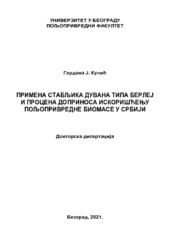Приказ основних података о документу
PRIMENA STABLJIKA DUVANA TIPA BERLEJ I PROCENA DOPRINOSA ISKORIŠĆENJU POLJOPRIVREDNE BIOMASE U SRBIJI
APPLICATION OF THE BERLEY TYPE TOBACCO STALKS AND EVALUATION OF THE CONTRIBUTION TO THE UTILIZATION OF AGRICULTURAL BIOMASS IN SERBIA
| dc.contributor | Radojičić, Vesna | |
| dc.contributor | Cvetković, Olga | |
| dc.contributor | Dolijanović, Željko | |
| dc.contributor | Rabrenović, Biljana | |
| dc.contributor | Srbinoska, Marija | |
| dc.creator | Gordana J. Kulić | |
| dc.date.accessioned | 2023-12-19T12:40:20Z | |
| dc.date.available | 2023-12-19T12:40:20Z | |
| dc.date.issued | 2021 | |
| dc.identifier.uri | https://nardus.mpn.gov.rs/handle/123456789/20769 | |
| dc.identifier.uri | http://aspace.agrif.bg.ac.rs/handle/123456789/6641 | |
| dc.description.abstract | Činjenica da stabljike duvana, kao biomasa, nisu bile predmet sistematičnih istraživanja, posebno ne na našem prostoru, su krucijalni razlog i opravdanje posvećivanju pažnje ovoj vrsti biomase. Eksperimentalna istraživanja ove disertacije su sprovedena na šest različitih oblika biomase: stabljikama duvana tipa Berlej sa lokaliteta Šapca, pšeničnoj slami i oklascima kukuruza sa lokaliteta Stare Pazove, sojinim stabljikama i ostacima glava suncokreta sa lokaliteta Golubinaca i piljevini drveta bukve, koja je preuzeta kao ostatak nakon mehaničke obrade drveta. Izvršeno je određivanje osnovnih agrohemijskih parametara zemljišta a na svim uzorcima biomasa urađene su analize hemijskog sastava, toplotne moći i produkata sagorevanja. Za prikaz meteoroloških uslova lokaliteta korišćeni su podaci Republičkog hidrometeorološkog zavoda Srbije (RHMZ) Srbije. Za potrebe pogonskog ispitivanja napravljeni su briketi od svih ispitivanih oblika biomase, bez dodavanja vezivnih sredstava. Prema hemijskom sastavu duvanska stabljika je u rangu sa pšeničnom slamom, boljih karakteristika u odnosu na sojine stabljike i naročito na ostatke glava suncokreta. Elementarnom analizom stabljika duvana utvrđeno je najmanje sadržaja C i najviše N u odnosu na ostale biomase (i do 5 puta više). Količina nikotina u dimnom gasu (< 10 ppm) je daleko ispod vrednosti zahteva Evropske unije. Vrednost toplotne moći duvanskih stabljika ne odstupa značajno od ostalih poljoprivrednih biomasa. Svi uzorci se nalaze se u granicama vrednosti regulisanih Uredbom o graničnim vrednostima emisija zagađujućih materija u vazduh, prema količini emitovanih C i N oksida. Na osnovu svih iznetih rezultata i poređenja sa karakteristikama ostalih ispitivanih oblika biomase, stabljike duvana tipa Berlej mogu imati upotrebnu vrednost kao biogorivo i sa energetskog i sa ekološkog aspekta. | sr |
| dc.description.abstract | The crucial reason and justification for focusing on tobacco stalks as biomass is the fact that it was not a scope of systematic research, especially not in our region. In this dissertation, experimental analysis of six various forms of biomass was performed: Burley type tobacco stalks from the Sabac region, wheat straw and corn cobs from the Stara Pazova region, soybean stalks and the remnants of sunflower heads from the Golubinac region, and beech sawdust obtained as remnants after lumber production. Fundamental agrochemical parameters of soil were determined and furthermore the analysis of chemical composition, calorific power, and products of combustion were determined for each sample of biomass as well. Data obtained from the RHMI of Serbia were used to present meteorological conditions for each corresponding locality. Briquettes of all types of biomass were made with no binder additives for the purpose of operational testing. Tobacco stalks are found to be similar in chemical composition to wheat straw and they possess better properties than soybean stalks and especially remnants of sunflower heads. Elemental analysis of tobacco stalks reveals the lowest content of C and the highest content of N (even up to 5 times greater content of nitrogen) compared to all other samples of biomass. Content of nicotine in flue gases (< 10 ppm) is far below the maximum level allowed by the European Union. Calorific power value of tobacco stalks is in range with other agricultural types of biomasses. According to the amounts of C and N oxides emitted, all samples fall in the range defined by the Regulation on the limit values for emissions of air pollutants. Based on all presented results and comparisons with characteristics of other investigated forms of biomass, Burley type tobacco stalks can be useful as biofuel considering both the energy efficiency and ecological aspect. | sr |
| dc.language.iso | sr | sr |
| dc.publisher | Univerzitet u Beogradu - Poljoprivredni fakultet | sr |
| dc.rights | openAccess | sr |
| dc.rights.uri | https://creativecommons.org/licenses/by/4.0/ | |
| dc.subject | stabljike duvana, | sr |
| dc.subject | pšenična slama, | sr |
| dc.subject | sojina stabljika, | sr |
| dc.subject | oklasak kukuruza, | sr |
| dc.subject | ostaci glava suncokreta, | sr |
| dc.subject | piljevina drveta bukve, | sr |
| dc.subject | hemijski sastav biomasa, | sr |
| dc.subject | toplotna moć, | sr |
| dc.subject | produkti sagorevanja. | sr |
| dc.title | PRIMENA STABLJIKA DUVANA TIPA BERLEJ I PROCENA DOPRINOSA ISKORIŠĆENJU POLJOPRIVREDNE BIOMASE U SRBIJI | sr |
| dc.title | APPLICATION OF THE BERLEY TYPE TOBACCO STALKS AND EVALUATION OF THE CONTRIBUTION TO THE UTILIZATION OF AGRICULTURAL BIOMASS IN SERBIA | sr |
| dc.type | doctoralThesis | sr |
| dc.rights.license | BY | sr |
| dc.identifier.fulltext | http://aspace.agrif.bg.ac.rs/bitstream/id/25342/bitstream_25342.pdf | |
| dc.identifier.rcub | https://hdl.handle.net/21.15107/rcub_agrospace_6641 | |
| dc.type.version | publishedVersion | sr |


